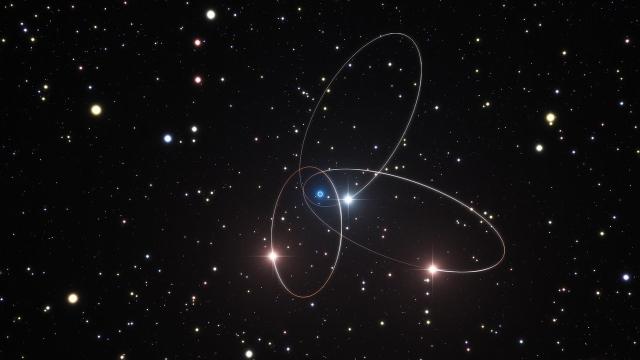The most basic physical laws you’ve learned — those drafted up by Isaac Newton in the 17th century — don’t work for everything. Once you try to applying them to really fast things moving nearly at the speed of light or things heavier than stars, they start to fall apart. That’s where Albert Einstein’s expanded theory of motion and gravity, the theory of general relativity, comes in.
Artist depiction of the three stars orbiting Sgr A* (Image: ESO/M Parsa/L. Calçada)
General relativity works really well, and has made predictions scientists proved a hundred years later. The question then becomes: Can you break it?
A team of scientists used 20 years of data from several telescopes to watch how three stars orbited the centre of our own Milky Way Galaxy, Sagittarius A*. They have created a general relativity theory test in a mass regime that isn’t well-tested today. The theory checks out, yet again… for now.
“Right now, this is basically a consistency test,” study author Andreas Eckart told Gizmodo. “We probed the data with what we expected from relativity,” and saw “very strong indications here that we got the expected answer”.
Scientists such as Einstein draft up theories to explain something they don’t understand. But once the theory exists, it should make testable predictions. Scientists must then continue to test the theory several ways: By proving these predictions really exist, like the gravitational waves discovery announced in 2016, or by trying to break the theory by applying it to more extreme cases as the researchers are doing here.
The team gathered data from several papers as well as observations from Chile’s Very Large Telescope on three stars, called S2, S38 and S55/S0-102. These bodies orbit Sgr A*, the presumed supermassive black hole four million times the mass of our own Sun at the centre of the Milky Way. The researchers were able to compare the stars’ orbits to the mathematical values Einstein’s laws predict. The team will publish their results in the Astrophysical Journal.
But this is far from a done deal. Despite two decades of data, the researchers only looked at three stars and saw a large uncertainty on their calculated value. There’s still plenty of room to potentially prove Einstein wrong. “To test whether or not there’s a violation you need to have a much much better signal to noise ratio,” said Eckart. More precise measurements can be done on these stars using other experiments to do much finer tests of relativity. “Whether that will lead to a modification, I cannot say.” The signal may be weak, but he hopes more data will improve the result.
But others think it’s an important step. “From my perspective, the exciting thing about this paper is that it improves tests of gravity in a regime that is not well-tested at the moment,” Tessa Baker, post doctoral researcher at the University of Oxford told Gizmodo. She pointed out that there is a lot of clutter and potential factors in the centre of the galaxy that can cloud a measurement there, but “it seems like they have done a comprehensive and careful job of accounting for these”. She’d also like to see how modifications to general relativity would show up in their measurements.
But what Eckart’s team has ultimately done is set up an easy-to-replicate system with further data for scientists who want to repeat the test.
“All the data is published in tables,” said Eckhart.” Using the new paper, “you could take the data from the tables and run it again.”
[ESO]
